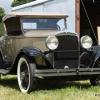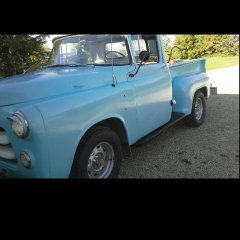-
Posts
131 -
Joined
-
Last visited
Reputation
120 ExcellentAbout oldasdirt
- Birthday 04/13/1938
Profile Information
-
Gender
Male
-
Location
According to my wife, from Mars
-
Interests
Old Plymouths, Chrysler and Mopars
-
My Project Cars
Well I have more projects than days left to finish them!
Contact Methods
-
Biography
those who know me call me Danny, or Grumpy !
-
Occupation
long since retired, now try to keep out of my wifes gun sights
Converted
-
Location
usa
-
Interests
old mopars without chevy or ford parts!
Recent Profile Visitors
2,657 profile views
-
Interesting.. That looks like a 331, 377 or 413 series engine. I have no experience with those so would have to concede to your experience. I know about 40 years ago when I was having issue with my 1st dual carb setup I ran into Eddy Kingsbury and saw a 265 with a factory dual carb setup on it and the fuel block had pretty close to equal length lines to each carbs. It was after that I went home, changed mine to a fuel block that I mounted on the fire wall and lines from there to the carbs. That was the only change I made and it went from running rough to running smooth. Since then I have done several multiple carb setups and done similar fuel block setups. That is not to suggest you need to go to the firewall. I can see good reason if your running metal lines not to go to the firewall. Now what I do see if the fuel block your running is prior to fuel bowls and the main jet. I wonder if that has an effect ?
-
Thanks for your illustration Don, showing my point quite well. You are, or were running a few block.albeit fairly close to the carb. In Toms case he has the point he is diverting fuel right up to the main jet. When I have done that years ago I got into the exact issues he is reporting. I have no idea in your case how similar your situation is. Something made me think I read you playing with electric fuel pump and lots of carb adjustments. In the end it matters not My point was I have found the further away from the connection to the carb you split the better.
-
Beautiful setup. I see you have one of the new AoK dual carb intakes. There are some great suggestions on the thread and the issue I see may not be the whole problem although from experience with dual carbs I know it can provide you the exact issue you had. Your running a fuel line to the 1st carb and t-ing right at the main jet to the other carb. That gives you an fuel pressure balance issue. The correct way to plumb it is to go from the mechanical fuel pump to a fuel block, and then run lines from the fuel block to each carb.
-

Transmission Refresh, R10 Overdrive, Need some info.
oldasdirt replied to Bmartin's topic in P15-D24 Forum
Ill drop you a note. Your into the 3 speed transmission side, grinding going into 2nd has nothing to do with the overdrive. The connection from the overdrive to the 3spd is the main shaft. I appreciate you are having problems but this isnt a DYI project and just coming up with a manual isnt going to turn this into a quick fix. If it was grinding going into 2nd its either clutch and pressure plate side or its the syncro in the transmission. If its a fresh rebuild I would expect someone had a look at the syncro. What you have is a syncro spring and it looks like it was ground going into 2nd until it was ripped apart. Ill drop you a note but time to circle back to the rebuilder here and or I will find you some help but right now its looking like a basket case -
1) yes 2) just changing jets is not a solution to running ethanol tossed into gas. Using real gasoline is the solution. 3) no Ansel Grose died, and no one has produced the jets since nor will you find it easy to find them. 4) I am sure I do, but a d6g1 which is a 1 9/16 throttle bore 1 ¼ venturi carb is not an island on to its own. Your center sections are more important that the top which can be and is often changed around. As taken from a document I have from Tim Kingsbury - 3 bolt – center section is 660 for Plymouth – starting 1950 2 bolt – center section is 635 - 1949 only 2 bolt – center section is 370 - 1939 – 1948 Answer - no they are not THe carb you have purchased has 1 11/16 throttle bore and 1 11/32 venturi. The main and other jetting can be changed but there is no getting around the throttle bore and venturi size as I think 55Fargo was eluding to. Sorry your last statement is just factually incorrect. Carter ball and ball made carbs for specific purposes and specifications and they provided carbs based on what their customers wanted. A stromberg 81 or 97 were carbs that the carb maker said - here is what we have.. its great, it will do what you want. sounds like another automotive guy - Henry Ford.. If he had. The three carbs you reference number in them are the cfm of the carb. In the case of carter ball and ball they not only ranged way lower and way higher in cfm but they also addressed various torque curves and transmission options that manufacturers would come up with. his way a model t would still be the only car you would need and its color would be black. I see so this thread went from you were documenting carb components which i had some interest in digging out all my carter ball and ball books, to your the expert and your using this to tune your dual carbs this summer.. rofl.. I also see you have bought Don C car which I am sure must be tuned to the nth degree because it was dons. Thanks for the laughs folks.. It reminds me why I dont spend much time on this site anymore. No offense and best of luck
-
They moved to 1 1/8 1st on the canadian 25 1/2" engine in the bigger truck engines and by 1951 all the canadian 25 1/2" camshafts have the larger hubs. I had George Asche tell me if he was regrinding a wild cam he would always use a 1 1/8" cam. That doesnt answer the reason why but given they seemed to start in the heavier trucks it likely had something to do with strength or longevity. A call to George Asche or Tim Kingsbury would likely reveal more than I have for you.
-

OD usage - and yes I am not getting my brain around it
oldasdirt replied to Thomba48's topic in P15-D24 Forum
The toggle switch is not to put it into overdrive. Its for when your in overdrive and you want to "kick it down" or remove it out of overdrive on the fly. If your on the highway in overdrive and want to pass, if you have a 1950s r10g1 wired originally you need to push the pedal to the floor so that the kickdown switch on the carb kicks it out of overdrive or if you have a toggle switch in the wiring, you can flick the toggle switch it takes it over of overdrive without needing to hammer the gas pedal. About 30 years ago I couldnt find a kick down switch and ran across George Asche at Chrysler Carlisle. He showed me his wiring harness and had several versions from factory original to a very modern version for 12 volts with electronic components. When I saw the toggle switch and he explained how it worked that gave me the ability to eliminate the need for a new kickdown switch on the carb. George gave me his wiring diagram for free and I used a heavy duty toggle switch mounted on my shifter. Worked like a charm. But its had nothing to do with getting it into overdrive its all about kicking it out of overdrive on the fly. -

OD usage - and yes I am not getting my brain around it
oldasdirt replied to Thomba48's topic in P15-D24 Forum
Ok Thom - Im a little confused. Are you saying your got the kickdown switch elsewhere ? In any case, if your remove the kickdown switch out of the harness, the toggle switch becomes a "manual kickdown switch". The electronic version used in the 1950s r10g1 overdrive on the carb can be removed from the circuit as long as their is a toggle switch. The toggle switch when opened breaks the circuit and then takes it out of overdrive. It wont ever go back into overdrive until the toggle switch is moved into the other position, closing the circuit. -

OD usage - and yes I am not getting my brain around it
oldasdirt replied to Thomba48's topic in P15-D24 Forum
Well the toggle switch you will use to kick it out of overdrive. it breaks the circuit. Which overdrive are you actually using ? the 1950s r10g1 ? If so since you seem to be able ot get it in Overdrive in 3rd you have the cable in the correct position. Depending on the model of overdrive you have will depend on what speed you need to be going to put it into overdrive. Lets start in 2nd.. You will start off in 1st, shift to 2nd and for mine when I am going around 35 mph you let off the throttle for a second, that puts it into overdrive and then put your foot back on the throttle. It will go into overdrive in 1st but again depending on the overdrive you need to be going a fair speed then let off the throttle to get it into overdrive. More than not, I am in overdrive in 2nd or 3rd and as I am slowing down, I shift down so when I come into 1st I am in overdrive. My question is how do you know the kick down switch you got from George Asche doesnt work ? Im asking because if you have the toggle switch in the open position, it will never go into overdrive. Are you sure that isnt what was happening ? Id put the kickdown switch back into the wiring harness and make sure I didnt have the toggle switch open. If it is really defective I am sure George will send you a replacement. -
Hi Stan - In my opinion, the best looking option is to turn your stock exhaust into headers. The flow as well as any headers out there, they last a lot longer than steel versions, and it places the back header exactly where the current exhaust exits and the front one if done right avoids the fuel pump and oil pump issues that many have. Give George Asche a call. 814-354-2621. Ive had the ones he build for me now for 30 years. Other than putting on better paint, and a decade ago I sent them and had Jet-Hot coat them, they are as I got them years ago. I dont know what the current cost is. Back then it was way cheaper than the Fenton header or steel options, although the truth is if they had costed more I still liked the look of them better than the other options.
-

1940 Windsor Coupe Triple Carb Manifolds-Which carbs to use?
oldasdirt replied to JPetrakis66's topic in P15-D24 Forum
Hi Adam - I think you really should read the AoK article. 3 carbs are definitely the way to go. If you want to dial it back with smaller jets or smaller throttle bores both net out less CFM sure then to your point the overall less total cfm has merit. In terms of how the flathead mopar engines work, with 3 siamese intake ports, as the AoK boys explain it 3 carbs are definitely the way to go. Overall better performance, better engine efficiency and potentially better fuel economy. -

1940 Windsor Coupe Triple Carb Manifolds-Which carbs to use?
oldasdirt replied to JPetrakis66's topic in P15-D24 Forum
I alway laugh when I read guys saying 3 are too much and you want progressive.. Based on what testing ? Eddy Edmunds made a triple in 1954 a couple of years after Chrysler offered factory dual carbs and headers on Trucks. The total CFM of those dual carb carter ball and balls exceed 3 of the 2 barrel carbs that Tom Langdon sells. The difference being they are purpose built for flatheads unlike the carter webers. A few things you likely should read 1) The AoK blog on this topic.. 2) Like others said - contact Tim Kingsbury and/or George Asche. The make in my opinion and many others the best in class dual and triple carb setups now. I run the triple on my big block 265 and a small block dual carb set up on a 230. There is nothing even close and over the years Ive tried many. 3) If you go through the AoK blog you will see Tim did a series of articles complete with pictures of various intakes over the years. Worth a read. I do applaud you for your effort. As a piece of art its awesome. As a performance intake based on what I do know I doubt it performs as good as it looks. The bowed runners I believe were a pre-war concept for a factory single carb setup. and the bases look too low but only testing would be able to confirm that. In reading the AoK blog regularly it seems they may have had issues with having theirs cast. Maybe an opportunity to join forces ??? George is now 85 I think and Tim's Dad which was a lot of his driving force passed away about a decade ago so I dont think they are planning on bulding any new designs. I asked George about an aluminum triple for a small block and he said it wasnt in the cards. Best of luck and keep working on flathead stuff.. love it! -
Yes I am very aware this is a truck forum. I clearly missed your thread with the "conversion in a couple of hours". Well Don, Im not taking the bait. Installed your t5 18 years ago. Really.. I guess it took 4 years from install until you drove it. https://www.jalopyjournal.com/forum/threads/makes-all-the-work-worthwhile.16533/ Don said - "I am just looking for details on how to do an A833 upgrade with documented photos. I may want to do such an upgrade myself " .. Seriously Don no one believes that. Just so your aware Tom Langdon was touting the conversion well before 2000, well before any mention of you doing it or yes people stealing your ideas. Clearly I just helped enable you to dive into this thread for your 21,518th post. Sorry about that folks. I will not be making that error again. Bye Don time to join the many and hit "block"
-
You really have two A833 4 speeds. 1 is cast iron and was the same tranny put in Hemis as it was a 318. The next generation is lighter aluminum case and it has overdrive in it. The cast iron ones are high demand and expensive and I have lots of experience with them. The aluminum ones are not as expensive although like so much of the 70s stuff that would have had these transmissions, they were crushed. That is the challenge and the issue.
-
Sorry I had to chuckle.. This from the guy who made his on intake and exhaust setup out of tube and stuff? I doubt it was a matter of what your time was worth and likely isnt for 55 Fargo Spitfire. Putting in an A833 OD or non-overdrive is exactly the same effort. It really was not a big deal vs putting in a T5 which was a big deal it really was. Getting a kit from Langdon for the T5 was a bunch easier than some of the step by step instructions I have seen on this site but it was still a lot of work and the shifter was too far back etc. The splits on the A833 are just fine but of course depends on what rear end ratio you have. The 1st one I did was now 15 years ago. Since I have or had a shop I own do more than a dozen of them. They have been behind 217s, 230s, 201s, 250 and 265 engines. For those who really are using a pickup as a car and maybe with the odd load of stuff its perfect. For those with older cars that had floor shift 3 speeds and are looking for an overdrive but are unable to find a decent r6 overdrive its a blessing.









